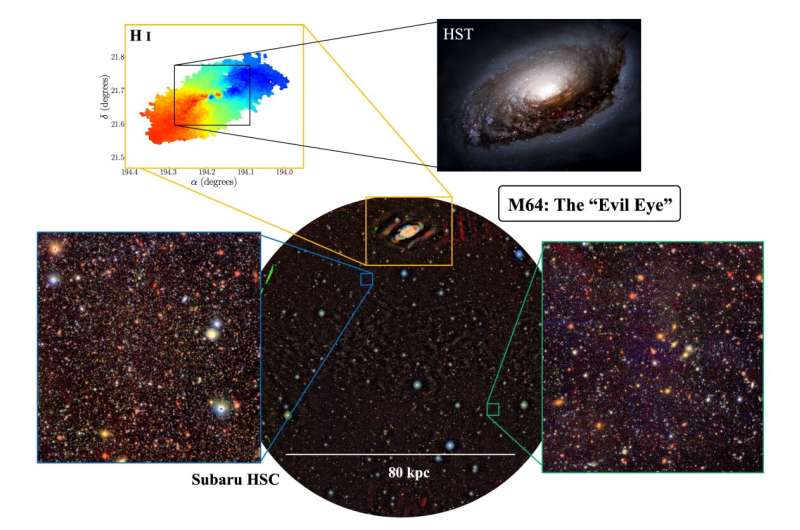May 30, 2023 report
This article has been reviewed according to Science X's editorial process and policies. Editors have highlighted the following attributes while ensuring the content's credibility:
fact-checked
peer-reviewed publication
trusted source
proofread
A closer look at galaxy M64's outer disk shows that it came from a smaller dwarf galaxy

An international team of astronomers, astrophysicists and cosmologists, has found evidence of galaxy M64's outer disk originating from a smaller, nearby, dwarf galaxy. The team has written a paper describing their findings that has been accepted for publication in The Astrophysical Journal Letters—in the meantime, it can be read on the arXiv preprint server.
Space scientists have known of the existence of galaxy M64 for two and a half centuries—it is notorious for its ominous appearance which has given rise to its nickname; the evil eye. Prior study of the galaxy has shown that it is unique in that its inner parts spin in an opposite direction to its outer parts.
This has led to speculation that the outer part was cannibalized from another nearby dwarf galaxy. Previous work has not, however, been able to find any evidence of the prior existence of the other galaxy. In this new effort, the researchers have finally found what the others had been looking for—material near M64 that was left over from another smaller galaxy as it was cannibalized.
To learn more about M64, the researchers studied data from the Subaru telescope's Hyper Suprime-Cam, looking at areas around the galaxy rather than at it directly. In so doing, they found evidence of a galactic halo—they are known to form during galaxy mergers.
And they also found a dense group of stars known as a shell—such formations also arise during galaxy mergers; gravitational interactions push them together. The team then created a simulation to depict the shell and it showed it to be consistent with prior findings with other minor galaxy mergers—where a smaller galaxy is pulled into a larger one.
The team then confirmed what they had observed by studying data from Hubble. It allowed them to make estimates regarding the composition and mass of the galaxy that they suspected had been absorbed.
They found both to be similar to the Small Magellanic Cloud, which is a small galaxy close to the Milky Way Galaxy—prior research has shown that it is slowly being cannibalized. The density was found to be approximately 500 million solar masses, which is roughly equivalent to the mass of the hydrogen disk forming the outer part of galaxy M64.
The researchers conclude by suggesting that taken together, their work offers a strong argument for cannibalization of a dwarf galaxy as the source of the outer hydrogen disk of galaxy M64.
More information: Adam Smercina et al, Origins of the Evil Eye: M64's Stellar Halo Reveals the Recent Accretion of an SMC-mass Satellite, arXiv (2023). DOI: 10.48550/arxiv.2305.17135
Journal information: arXiv , Astrophysical Journal Letters
© 2023 Science X Network




















